Black and white spiders can be found all around the world. These spiders may or may not build their spider webs, depending on their genus.
Not all black and white spiders are the same as they represent completely different species.
The Zebra Jumping spider is one of the most popular black and white spiders. Its name is directly influenced by its black and white color.
The following species have different ratios of black and white coloring. Some are black-dominant while others are white-dominant.
1. Bold Jumping Spider – Common Black Spider With White Spots or Dots
Scientific name: Phidippus audax
Common name: Bold jumping spider, bold jumper
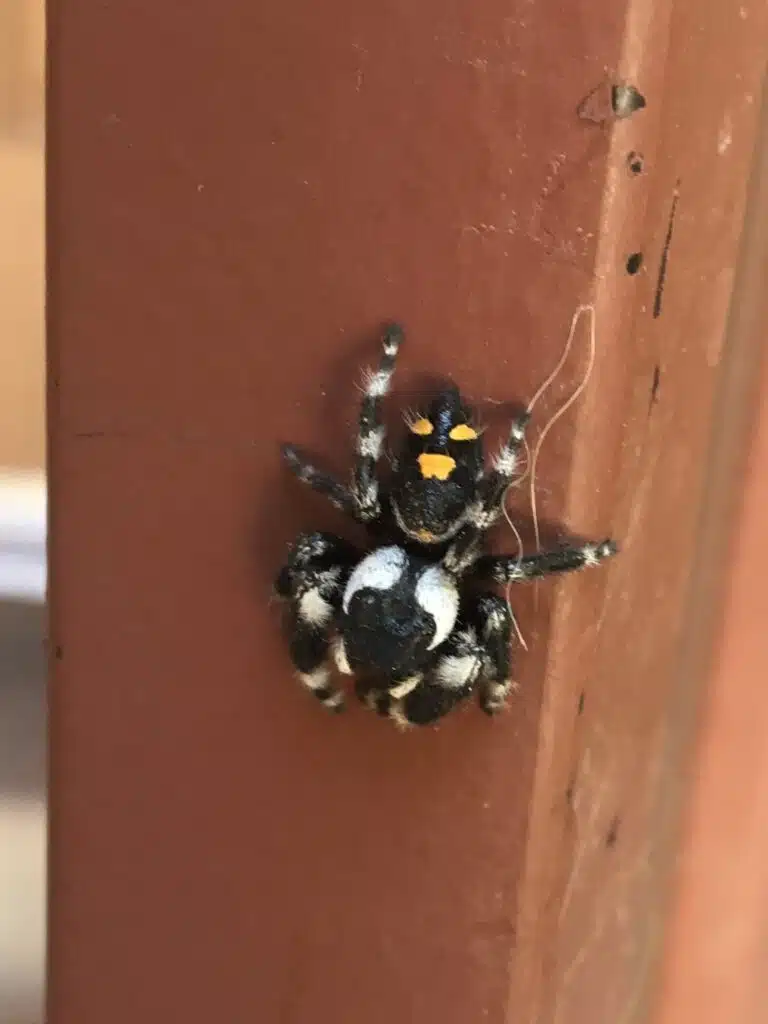
The Bold Jumping spider is dominated by black and white colors. This species is known for being black-dominating.
White lines sometimes extend on their dorsal.
Bold Jumping spiders are venomous and they do bite when roughly handled. Not poisonous to people, these spiders are still venomous.
They live in grasslands, prairies, and other areas with vegetation.
Spiders of this genus are diurnal. They spend most time of the day hiding or looking for prey.
They use excellent vision to approach and pounce on prey.
Insects and smaller spiders are among its preferred foods.
These spiders play an important role in ecosystems as they can control insect populations.
High reproduction rates help them control insects better.
The average Bold Jumping Spider female lays around 200 eggs per season, mainly in the spring or summer.
2. Spinybacked Orbweaver
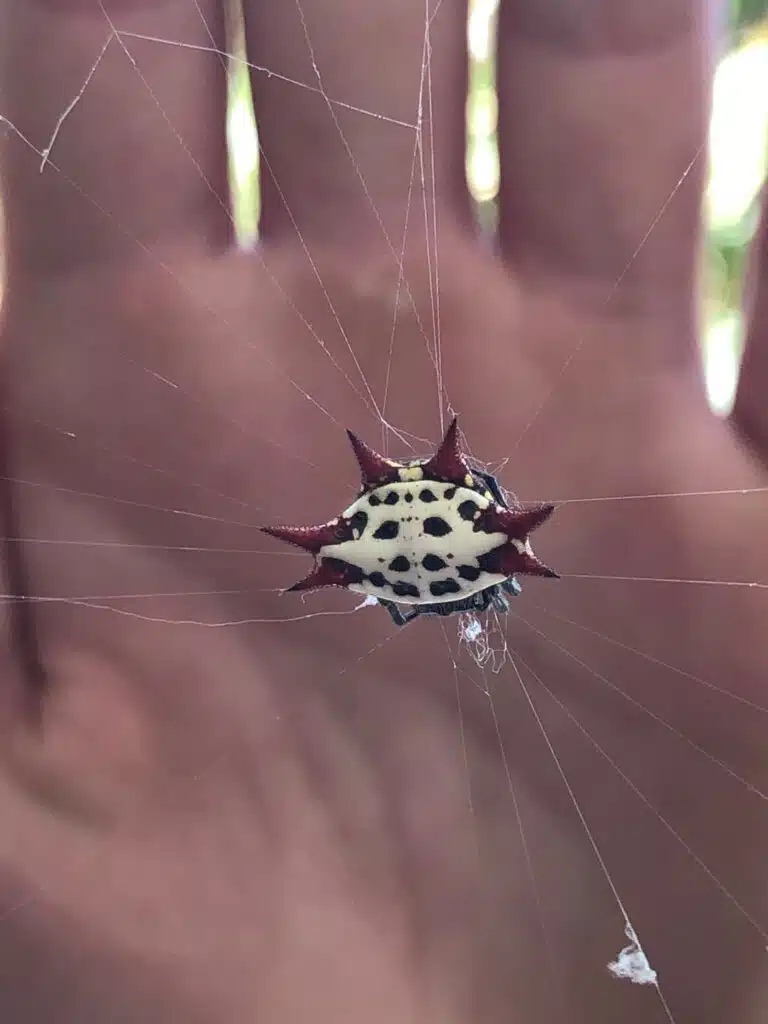
Scientific name: Gasteracantha cancriformis
Common name: Spinybacked orbweaver
The spinybacked Orbweaver is a black and white species that’s white-dominant. The dorsal white of this genus also shows small black marks.
Spinybacked Orbweaver spiders are also known for their abdominal projections. 6 projections make these spiders look atypical or asymmetrical.
These spiders are known for living in colonies.
Spinybacked Orbweaver spider colonies number up to a few thousand individuals.
Many colonies are found in woodlands and dense vegetation.
Some of the most active spiders of the genus are found in Florida. Warm weather favors high activity levels throughout the year.
Many Spinybacked Orbweaver spiders are found on citrus plantations in Florida.
However, the distribution of the species is wide. Its habitat expands from Southern US territories to South American territories.
3. Zebra Jumping Spider – Black Spider with White Stripes
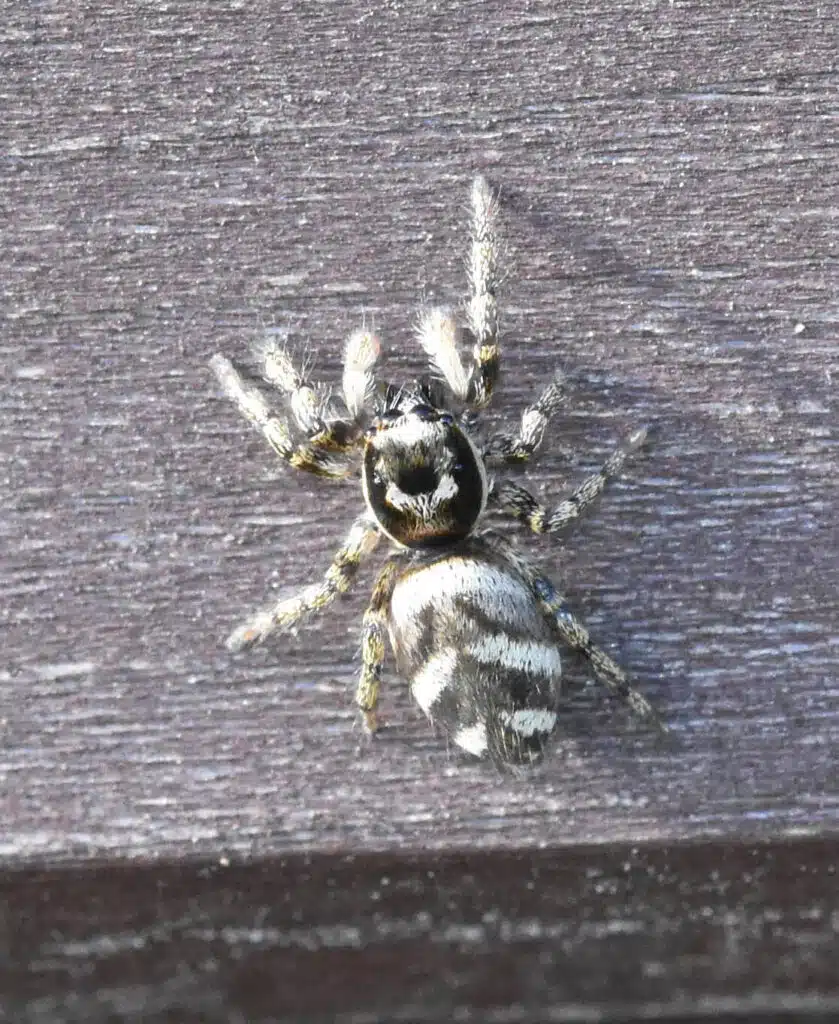
Scientific name: Salticus scenicus
Common name: Zebra jumping spider
The Zebra Jumping spider is one of the largest black and white jumping spiders.
Coloring is typically unchanged in the species as both black and white colors are present in similar percentages across the hairy body of this spider.
Female Zebra Jumping spiders are larger than male spiders.
The maximum size of a female is 9mm while the maximum size of a male is 5mm.
Found across North America, Europe, and parts of Asia, the Zebra Jumping spider is a species that doesn’t spin webs.
It uses vision to pounce on prey. Lateral eyes are used to quickly detect motion around the spider so that it doesn’t miss any prey.
Seen in all habitats including beaches, these spiders prefer to live next to trees and buildings as they are often seen across vertical surfaces.
Spiders of this genus have a varied diet that includes very large prey, in comparison to their size.
Zebra Jumping spiders are often seen taking on moths twice their size.
4. Spined Micrathena
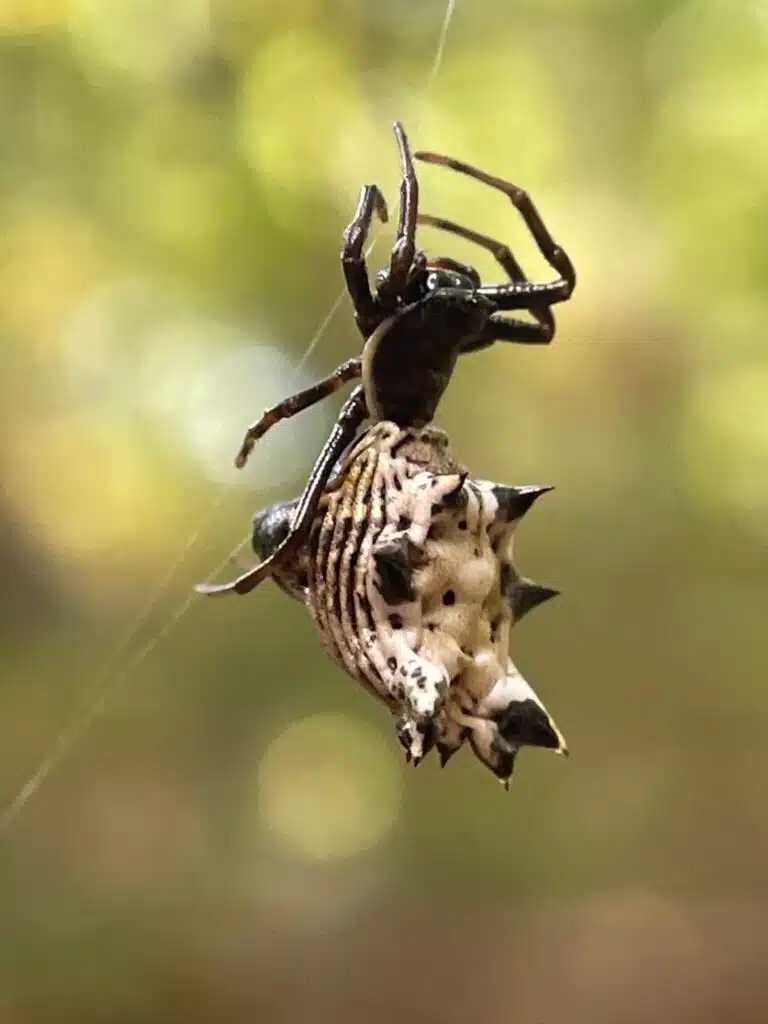
Scientific name: Micrathena gracilis
Common name: Spined micrathena, castleback orbweaver
The Spined Micrathena is identified by the ridges on the female’s body. These ridges are believed to have a role in protecting the spider from predators.
It’s believed the spined spider can hurt predators trying to eat it.
However, these spines or ridges are only seen in females.
The black and white contrasting colors are more pronounced in male Spined Micrathena spiders.
You can also find this species in other colors as it has a varied look depending on its habitat.
It also comes in orange and brown.
Spined Micrathena spiders grow up to 10mm and aren’t known to bite. They spin orb-shaped web weaves which are fixed at the end of each day.
Active until October, the species isn’t venomous.
It can be found in a wide range of habitats where it can attach its orbital weave.
5. Coppered White-cheeked Jumping Spider
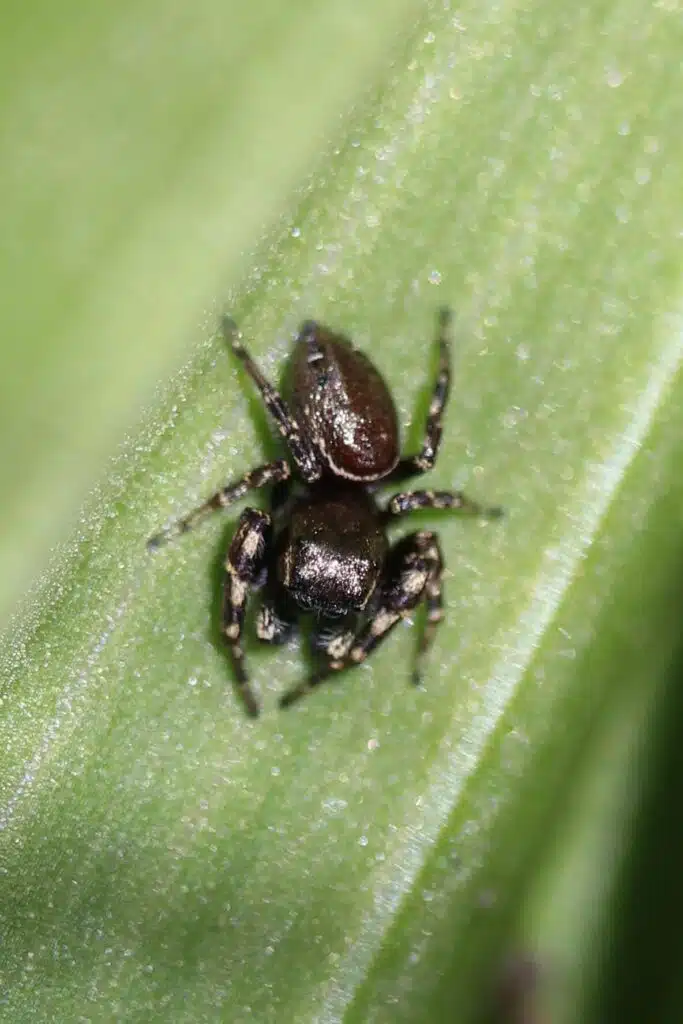
Scientific name: Pelegrina aeneola
Common name: Coppered white-cheeked jumping spider
The Coppered White-cheeked Jumping Spider has black, white, and brown coloring.
White is dominating in females while black is dominating in males.
The female Coppered White-cheeked Jumping spider has white legs and brown and black markings.
Male spiders have a black body with white spots and black and white legs. Males also have brown nuance dorsal coloring.
Differences between females and males are considerably smaller when it comes to sizing.
The female is only 0.5mm larger than the male spider.
Female Coppered White-cheeked Jumping spiders grow to 5.5mm.
Males grow up to 5mm.
Both males and females have a row of 4 principal eyes. The central pair of eyes is larger although the 2 lateral eyes are used to detect the motion of insects and other prey.
These spiders eat insects and insect eggs and can be seen in Western parts of the US.
6. Red-femured Spotted Orbweaver
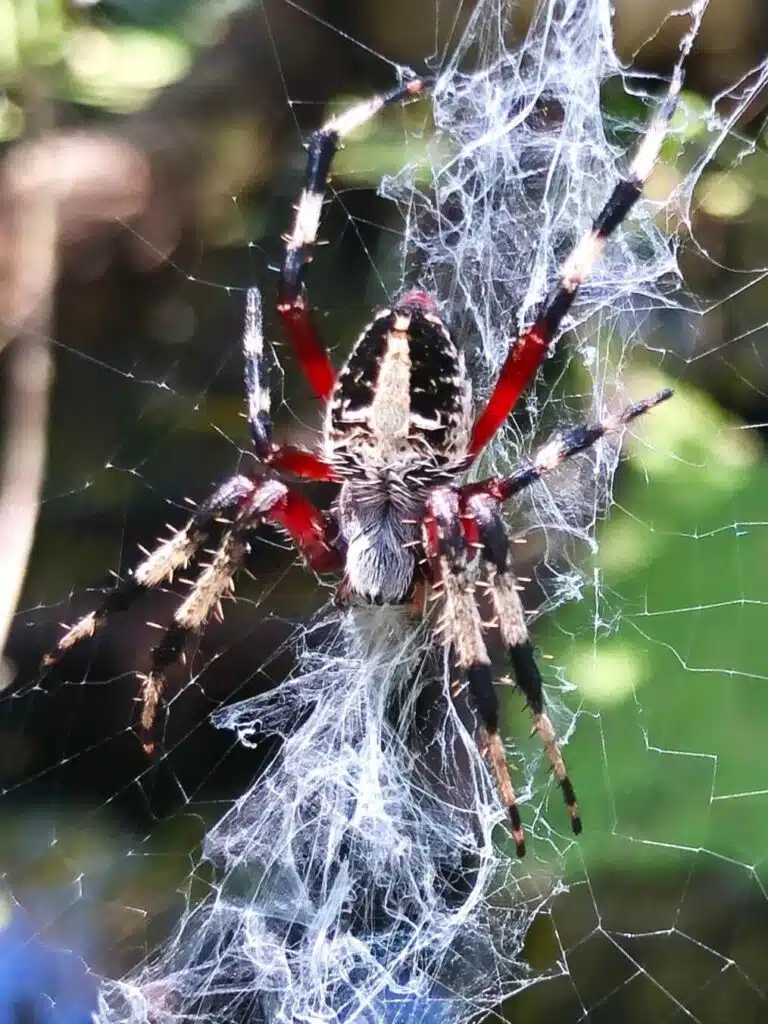
Scientific name: Neoscona domiciliorum
Common name: Red-femured spotted orbweaver, spotted orbweaver
Known for its black and white body, this species also has red legs and a distinct profile of colors that stand out.
The colorful spider species is an orbweaver. It makes vertical web weaves to catch insects.
This spider species is further known for making its web weave in the evening and for taking it down in the early morning.
Females might be seen on web weaves in the summer when they leave them on during the day.
It’s believed higher nutritional needs for mating purposes make the female leave the weave on during the day in the summer.
These spiders are nocturnal and very difficult to spot out in nature, even in hardwood forests where they are like to live.
Some of these spiders are found in suburban areas but are only seen at night.
7. Eastern Parson Spider
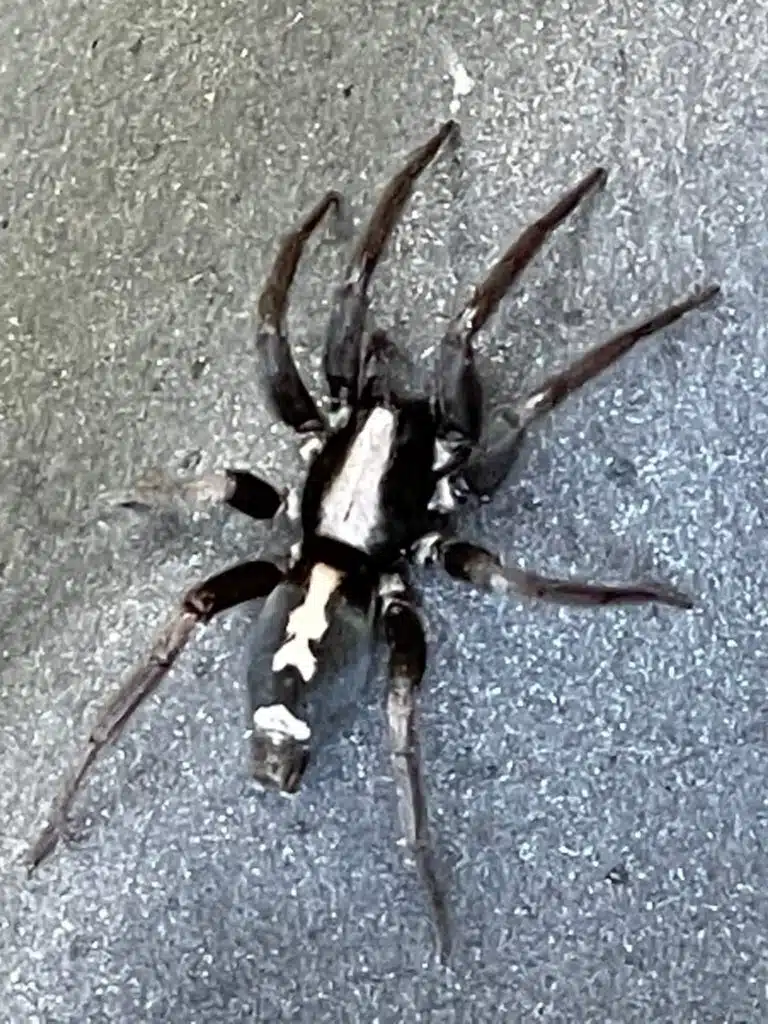
Scientific name: Herpyllus ecclesiasticus
Common name: eastern parson spider
The Eastern Parson spider has a white necktie-shaped marking on its black body. This species is highly common in North America.
Spiders of this genus are predators and they don’t spin spider webs.
They follow and ambush various prey such as insects.
The spider is very active and it prefers to hide under rocks, wood, and leaves to ambush its predators.
Some people report these spiders biting. However, its bite doesn’t have any medical importance as it’s not a venomous species.
Eastern Parson spiders move fast. They can even move indoors seeking prey to ambush.
This is not an invasive species in homes and as a result, it’s not dangerous indoors.
The spider normally makes its way out on its own.
Outside of the home, it remains very active at night. It can be seen on flat and vertical surfaces moving around quickly to find food.
It can sometimes be found in suburban areas on walls with lights on them which tend to attract most insects at night.
8. Noble False Widow
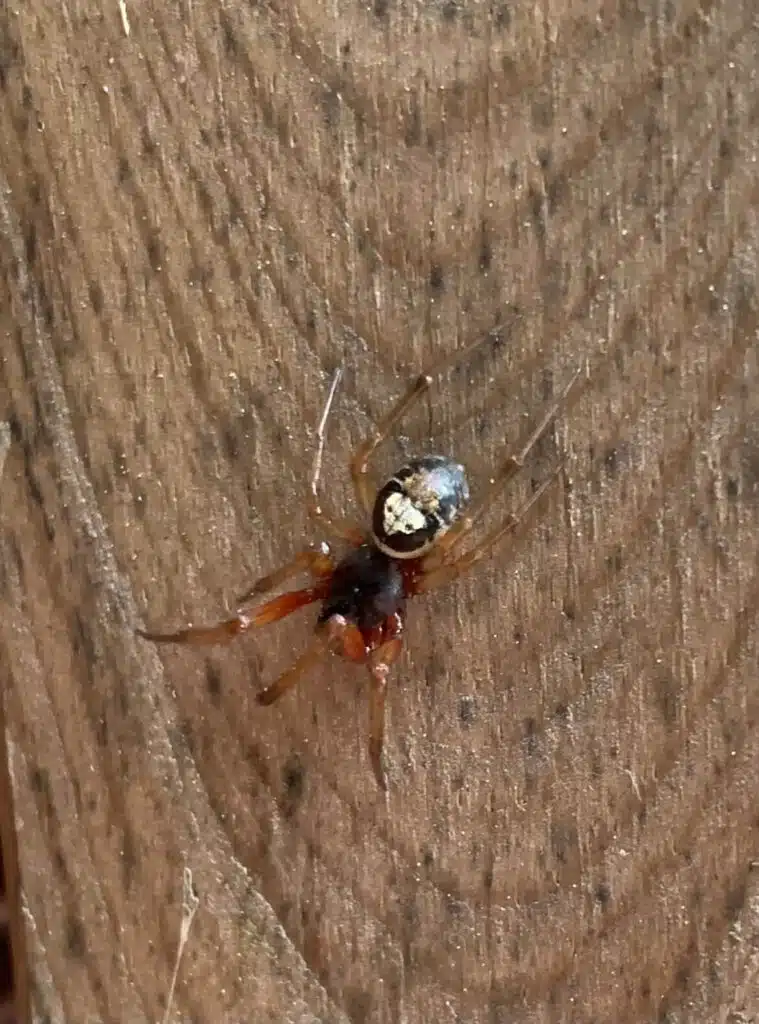
Scientific name: Steatoda nobilis
Common name: Noble false widow
The Noble False Widow is a feared spider species for its excellent predation skills.
This species makes some of the strongest cobwebs which allows it to catch all types of insects and even mammals.
Noble False Widows are potent spiders that even catch mammals such as bats.
This species has been shown to constrict its prey by building a cocoon around it and by injecting venom into the victim.
Paralysis is the result of this venom injection. Even large prey such as bats is paralyzed by this spider.
The venom of this species is known to induce rapid paralysis in the victims of the species.
Prey caught up on the web and is paralyzed within minutes.
These spiders live in diverse habitats, almost everywhere they can find food.
Noble False Widows aren’t afraid of setting indoors as well.
9. Gray Wall Jumping Spider
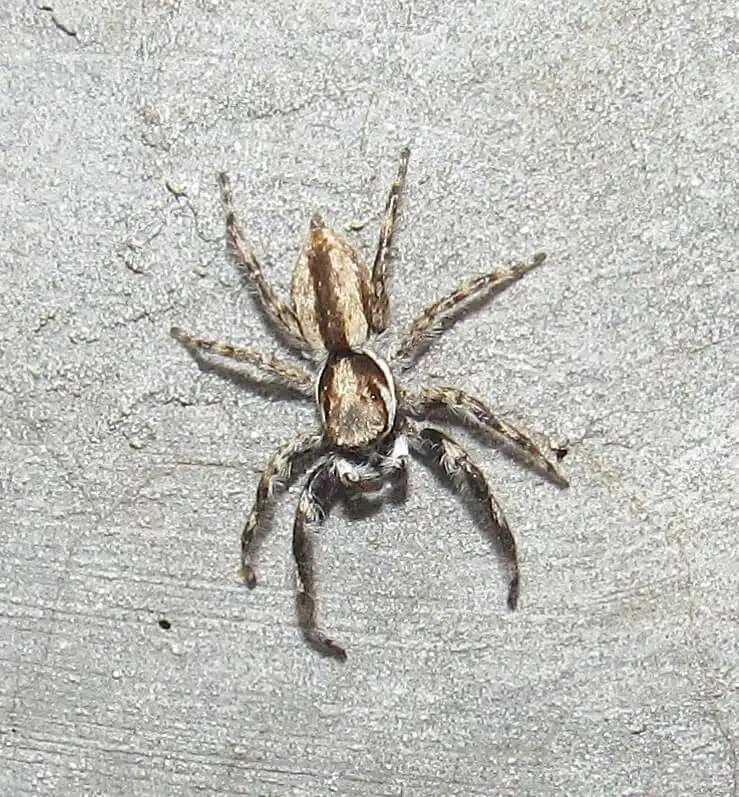
Scientific name: Menemerus bivittatus
Common name: Gray wall jumping spider, gray wall jumper
The Gray Wall Jumping spider has been introduced to the US from Africa.
Spiders of this species are now present in Texas, California, and Florida.
This agile spider jumps, as its name suggests. It pounces on prey such as crane flies efficiently.
Male spiders exhibit the most black and white colorations. Horizontal black and white stripes are seen across the body of the smaller male.
Females of the species are larger as they grow to 10mm.
This species of jumping spider is also known for having a complex mating ritual.
Males are even known for making distinct sounds during this courtship ritual to attract females.
This species is mostly seen on walls and tree trunks. Its ability to climb walls makes it an efficient predator looking for various flies attracted to lights and windows.
10. Bronze Jumping Spider
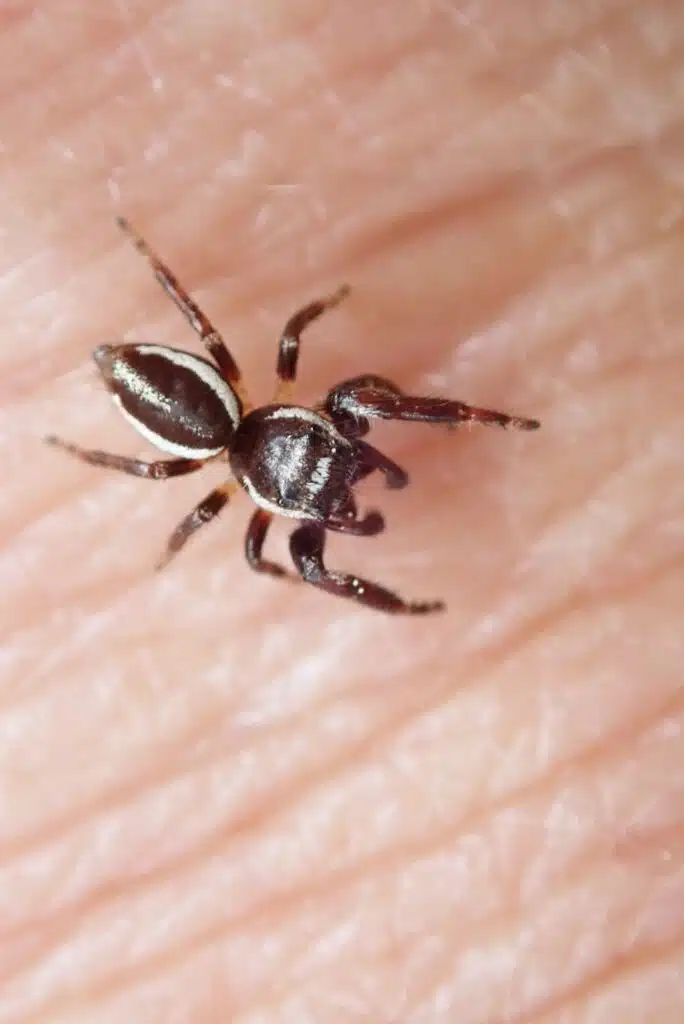
Scientific name: Eris militaris
Common name: Bronze jumping spider, bronze jumper, bronze lake jumper
The Bronze Jumping spider has a combination of colors including bronze, that inspires its name.
This species also has black and white coloring, that’s dominant on the cephalothorax.
Spiders of this genus have a black cephalothorax with a white band that runs across the sides of their body.
Bronze Jumping spiders have slightly different colors depending on their gender.
It’s the male spiders that seem to have the most vivid colors and the best black and white contrast.
These spiders also show bronze color hairs on their legs.
2 large central eyes and 2 smaller lateral eyes help this spider move along any surface looking for food.
The smaller 4 eyes at the back are only believed to play a minor role in this species’ vision, as with most jumping spiders.
It’s not afraid of coming close to homes and it’s often seen on the walls around lights and windows.
This spider is very aggressive but not dangerous to humans. It bites people as soon as it gets the chance but the associated pain only lasts a few seconds.
11. False Black Widow
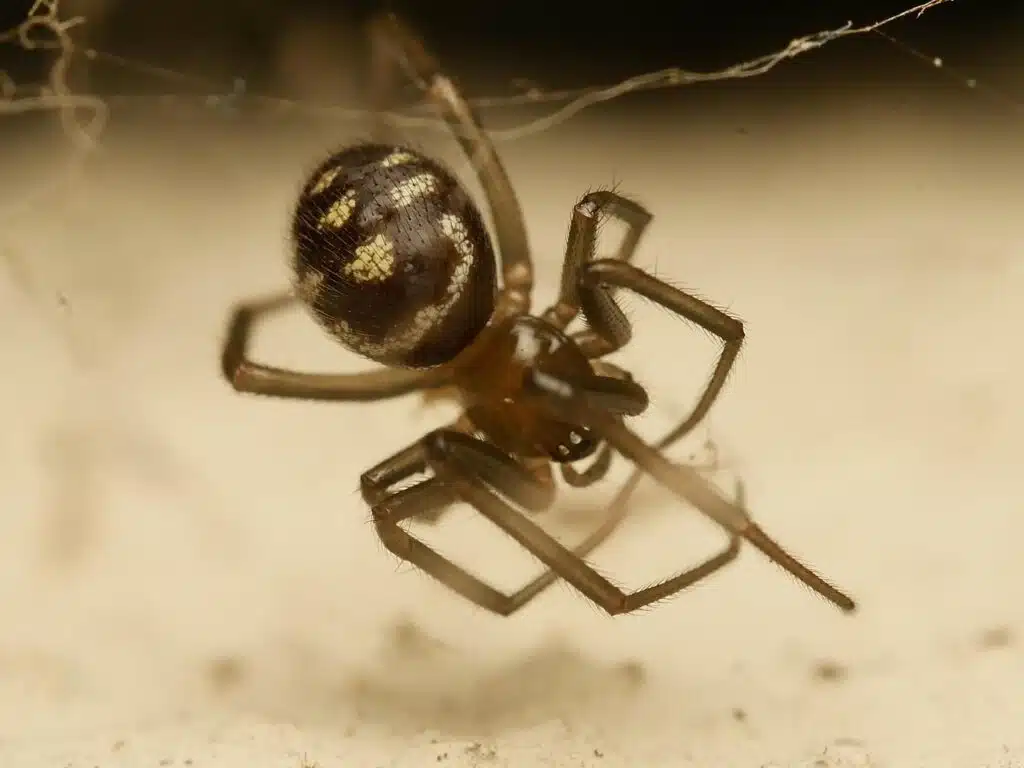
Scientific name: Steatoda grossa
Common name: False black widow, false widow, cupboard spider, dark comb-footed spider, brown house spider
The False Black Widow is brown in the case of females and black, white, and brown in the case of a males.
Spiders of this genus grow to a size of up to 10.5mm.
False Black Widows are found everywhere they can set up their spider webs.
These spiders have very poor vision compared to the Bronze Jumping spider. They can’t use their vision to look for prey or to guide them to bite people.
Spiders of this genus depend on the vibrations of the spider web to get notified of possible prey and food.
These spiders can bite people, but only when roughly handled.
Spiders of the genus are venomous and while not deadly, they come with all types of reactions to biting people.
Fever is one of the more severe reactions to the bite of these spiders.
People can also get bitten unexpectedly when this spider confuses them with prey.
Swollen skin is common in the area of the bite.
Sweating and nausea are also common whenever this spider bites.
The venom of this species is considered less harmful than the venom of the Redback Black Widow.
12. Peppered Jumping Spider
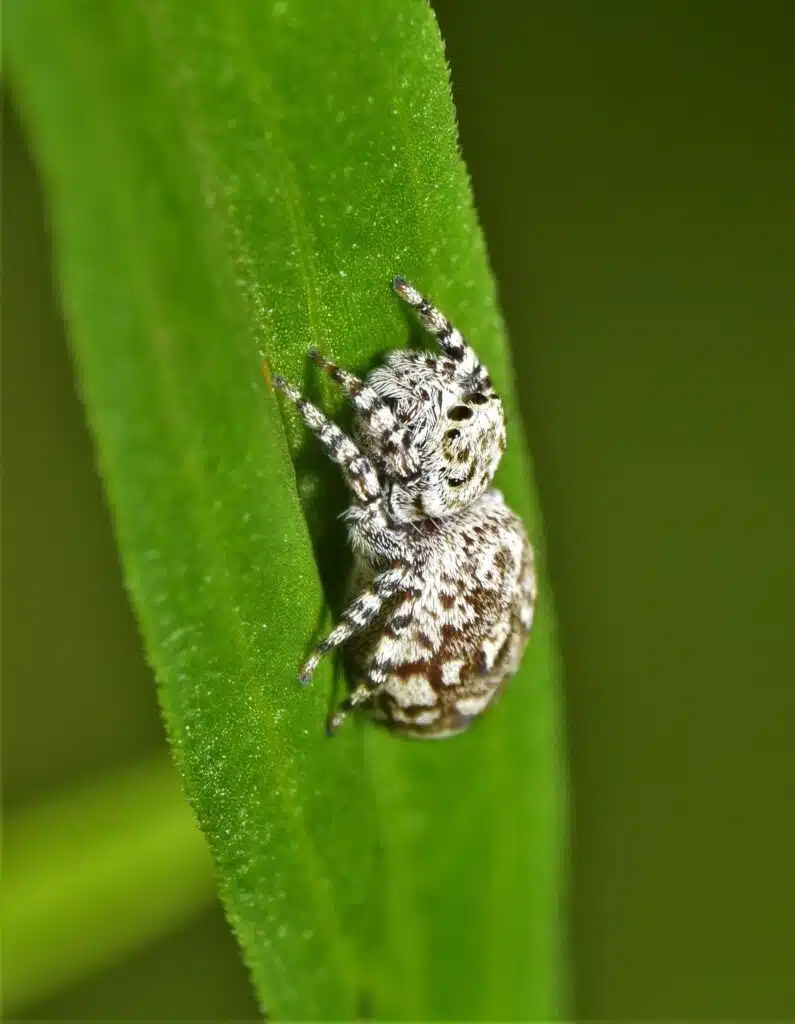
Scientific name: Pelegrina galathea
Common name: Peppered jumping spider, peppered jumper
The Peppered Jumping spider is one of the smallest black and white spiders living in North America.
Males of the species can be as small as 2.7mm but they can grow up to 4mm.
Females are larger as they grow up to 5mm.
A black cephalothorax is common in males and females with white marks across.
Spiders of this genus are common on US crops. They are also found in agricultural fields across the world.
It’s believed they have a beneficial insect-control role.
They are most common in abandoned crops and abandoned farms.
Peppered Jumping spiders are known as agile. They climb any vertical surface such as walls for food.
13. Buttonhook Leaf-beetle Jumping Spider
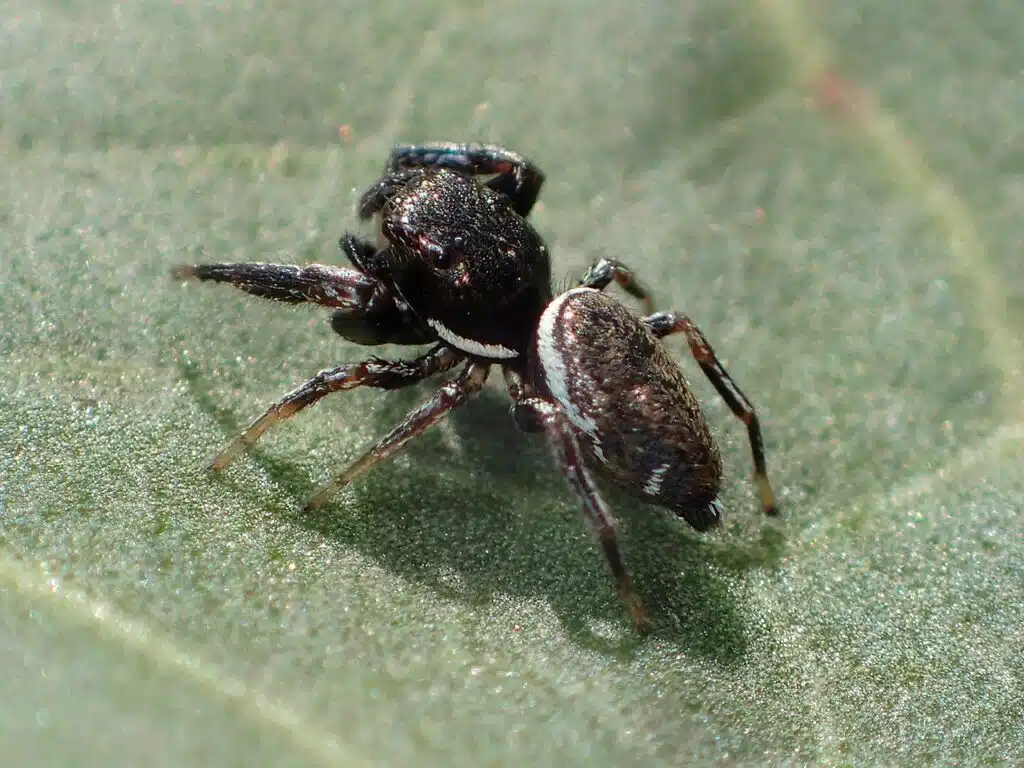
Scientific name: Sassacus vitis
Common name: Buttonhook leaf-beetle jumping spider
The Buttonhoog Leaf-beetle Jumping spider is common across the US. This is one of the small jumping spiders in the country.
Females grow to a size of just over 5mm while males grow to a size of nearly 4mm.
Both species are multi-colored with black and white making the bulk of their coloring along with brown or bronze.
The cephalothorax is mostly black with white bands across the sides. These bands are connected.
White marks are also common in other areas of the body such as on the legs.
Known as a small species, these spiders are among those most interested in small prey given their reduced size.
Gnats are among their favorite foods as they’re smaller than many other types of flies.
14. Pantropical Jumping Spider
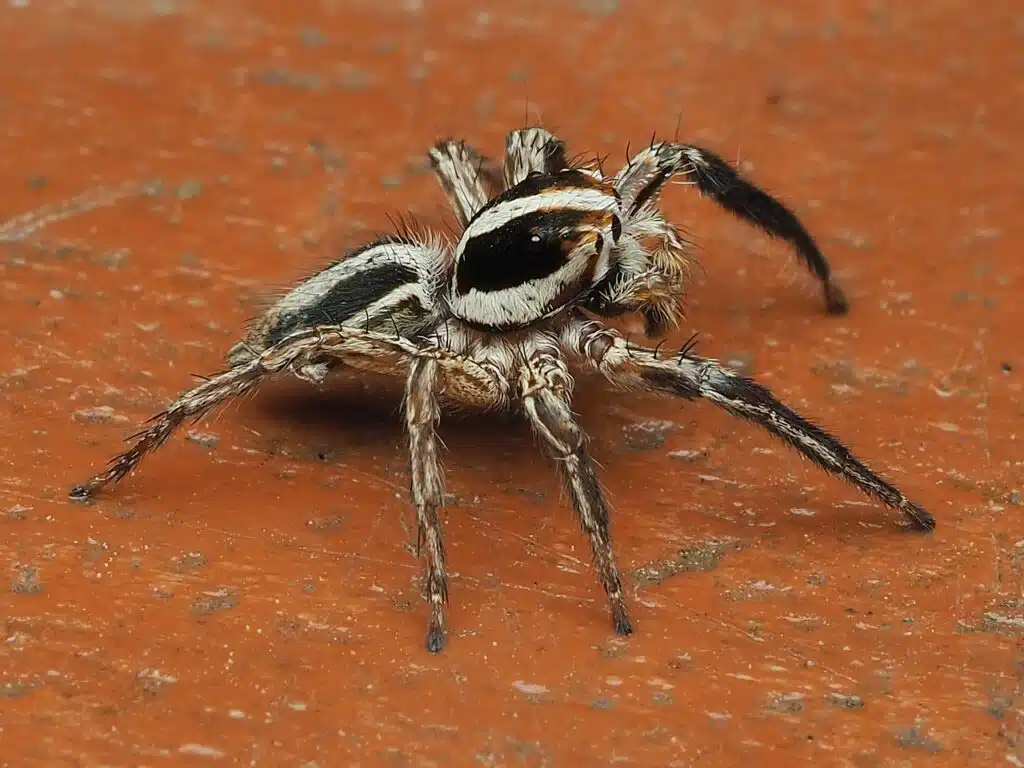
Scientific name: Plexippus paykulli
Common name: Pantropical jumping spider
This species of jumping spider has been introduced from Asia. There are considerable coloring differences between males and females.
The female spider has a more pronounced brown coloring while males have a black cephalothorax with a white central line (tan line in females).
Spiders of this species are known for their very good hunting skills and very good vision, just as many other jumping spiders.
They don’t build spider webs but small silk cocoons they use as shelter and hiding spots.
These cocoons are normally seen in elevated positions such as high on walls or tree bark.
Spiders of this genus are known to eat mosquitoes.
However, they are most common on citrus groves in Southern territories.
These spiders also eat other spiders as well as large prey.
While they can be overpowered by other bugs, these spiders use their potent venom to quickly immobilize prey.
Given these spiders have a good vision they can approach different types of prey. They can quickly pounce on flies so they don’t escape or slowly move up to fly larvae as it doesn’t move.
15. Bowl-and-doily Spider
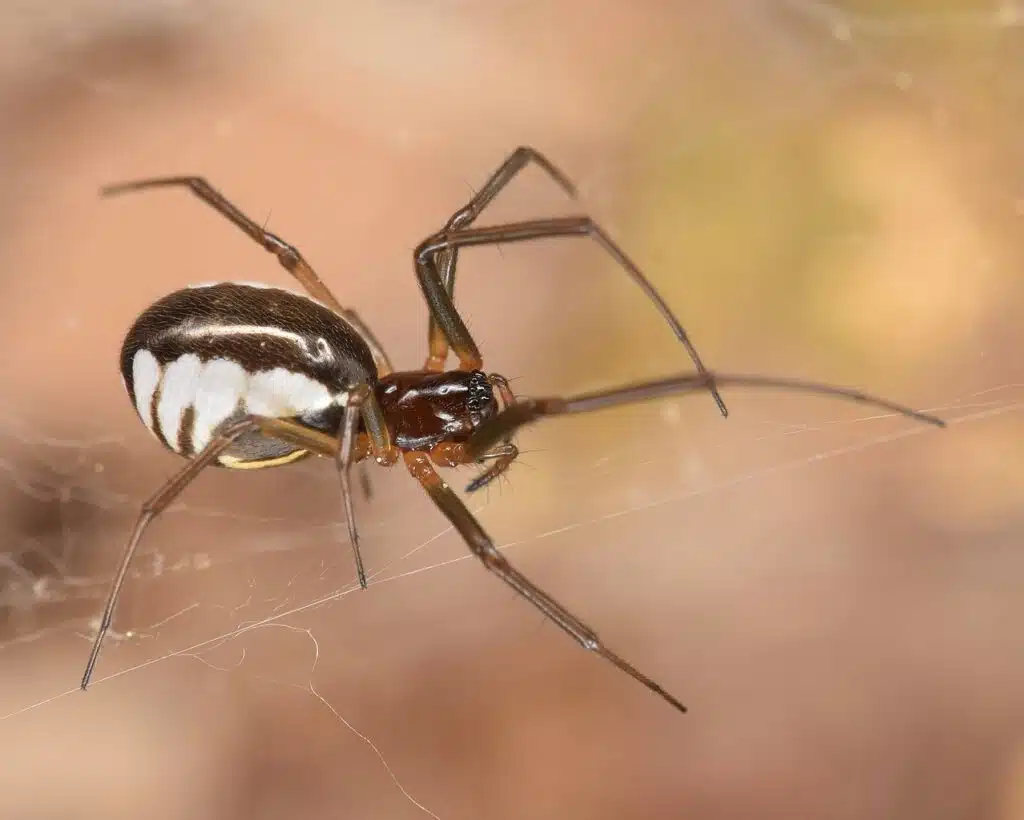
Scientific name: Frontinella pyramitela
Common name: Bowl and doily spider
This spider species have been introduced to North America. It represents a web-weaving species specialized in catching small flies and gnats.
Spiders of this genus are rather small, as they grow to 5mm.
One of the most difficult tasks is to correctly identify this species around the house.
It comes in multiple colors which makes for more difficult correct identity.
Some males of this species are black and white, with red-brown legs.
Spiders of the family are solitary and they only meet for mating.
The male seeks out the female’s nest where mating happens. Males remain in the nest for a short period after mating.
This is atypical for this species as males leave the female soon after mating.
There’s no obvious departure date for males from the female’s nest. Some stay longer while others leave a few days after mating with the female.
This species is also known to possess very good prey memory.
Skills of this genus allow the species to correctly identify the most recent prey parts even when mixed with older prey parts.
16. Sylvan Jumping Spider
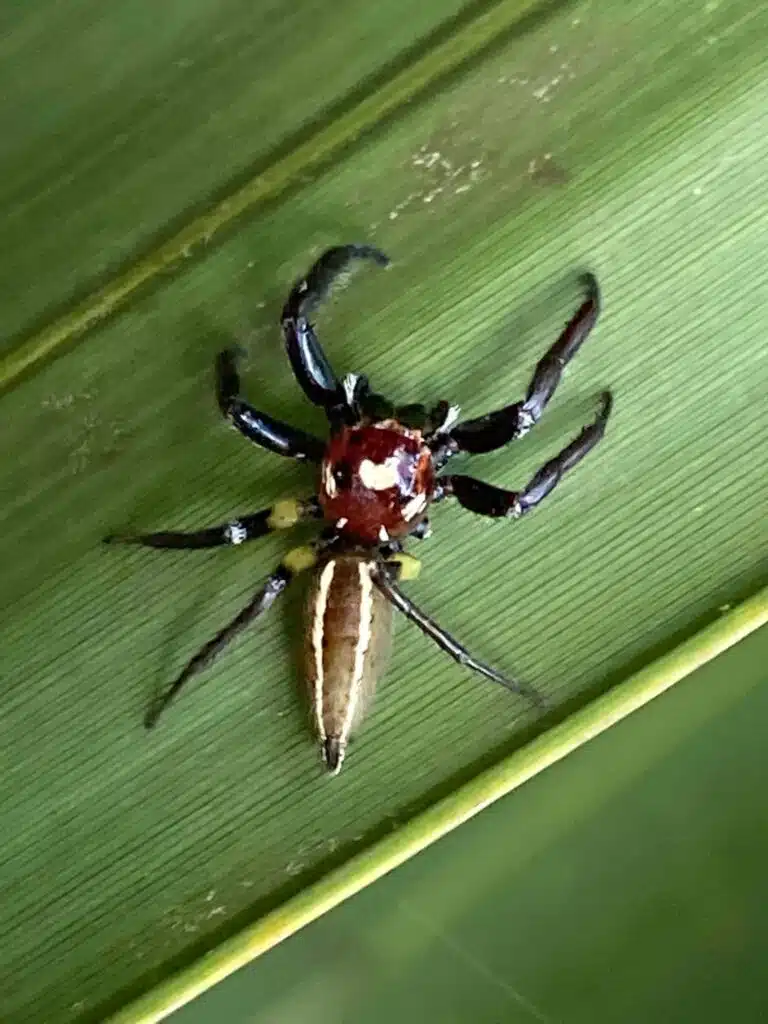
Scientific name: Colonus sylvanus
Common name: Sylvan jumping spider
The Sylvan Jumping spider is one of the species where the male looks completely different from the female.
The female Sylvan Jumping spider has a tan color with white marks on the cephalothorax.
Males have a black and white body with a brown abdomen and red coloring around their eyes.
Males have all-black legs.
Common on trees and flowers, the Sylvan Jumping spider is believed to be a native species.
It feeds on very small insects as it barely grows to 5mm.
The exact diet of the Sylvan Jumping Spider is unknown as there’s little research on the species.
All files up to the size of gnats are believed to be part of its diet.
Like all jumping spiders, the Sylvan Jumping spider has 8 eyes, 4 of which are truly principal while 4 are secondary smaller eyes.
Its principal eyes are easily visible as they’re located in the front of the head. The 2 central eyes in a row of 4 are the largest.
The secondary eyes are located further to the sides of the head and are believed to offer the least amount of information.
17. White Micrathena – White Spider with Black Spots
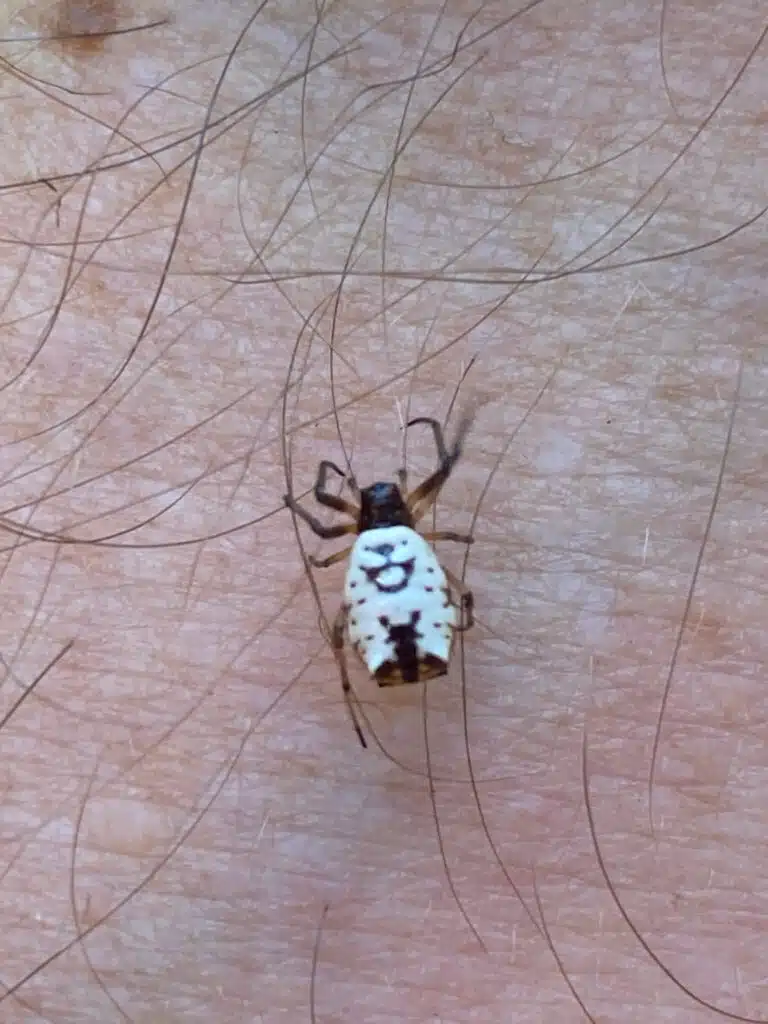
Scientific name: Micrathena mitrata
Common name: white micrathena
The White Micrathena species is one of the most common Micrathenas in the US.
This spider has a distinct bulbous white and black body.
White is the base color of its body but it also exhibits black blotches.
Spiders of this genus have spiny protrusions in their lower abdomen.
Larger than other Micrathena spiders, the White Micrathena species grows to 0.5 inches.
However, it still consumes all types of small and very small insects.
These spiders build large spider webs they use to catch all types of gnats. Mosquitoes are also easy prey with all small spiders.
Spider webs are useful even for the largest prey. The strongest area of Micrathena’s web is the center point.
This is where most large flies get caught up in.
It’s believed you should not kill these spiders when you find them outdoors for their beneficial role in gardens.
It’s here they eat mosquitoes that grow in moist areas as well as other plant pests.
18. Common White-cheeked Jumping Spider
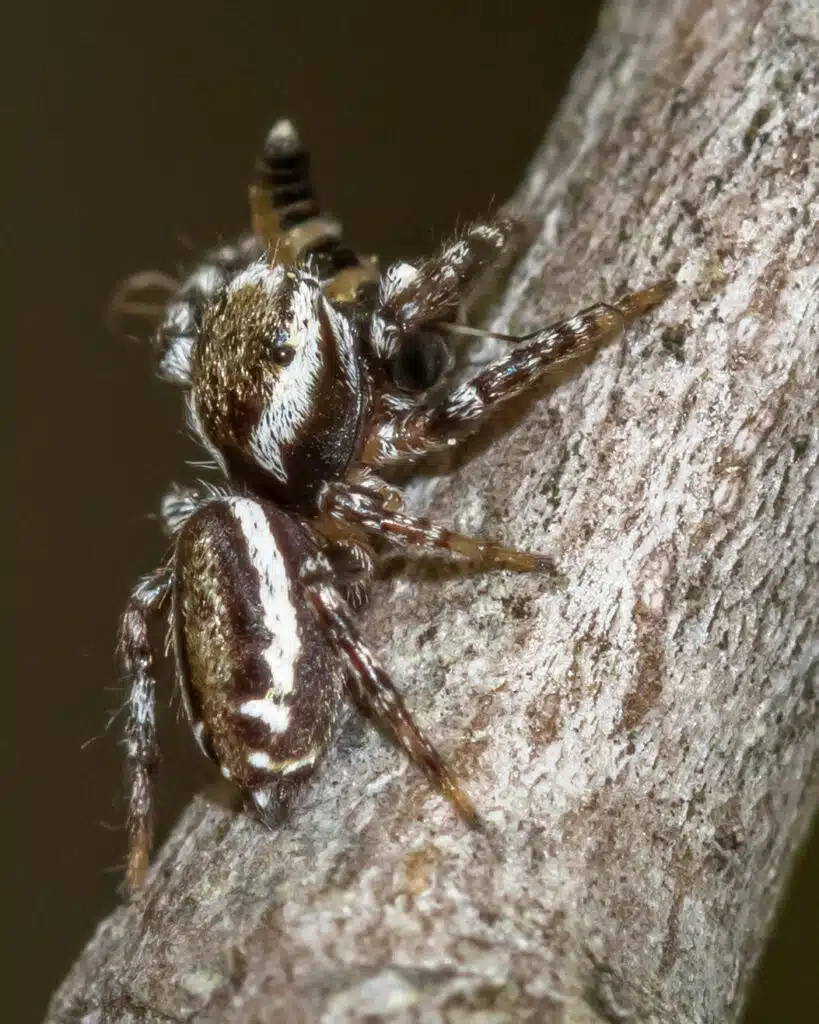
Scientific name: Pelegrina proterva
Common name: Common white-cheeked jumping spider
The Common White-cheeked Jumping spider is common in Easter US, particularly in the area of Boston as well as in Eastern Canada.
Its habitat is expanding and it has been sighted as far as Montana.
The Common White-cheeked Jumping spider is a species where males and females have different coloring.
It’s the male that comes in a dark brown and white or a black and white version while the female has a light brown and white or light brown and tan coloring.
Spiders of this genus have thick hairy bodies, as many introduced jumping spiders in the US.
They are small and comparable in size to other jumping spiders.
Males grow to 4.2mm while females grow to 5.6mm.
The species is known for eating a wide range of insects, including the Common housefly.
19. Long-palped Ant-mimic Sac Spider
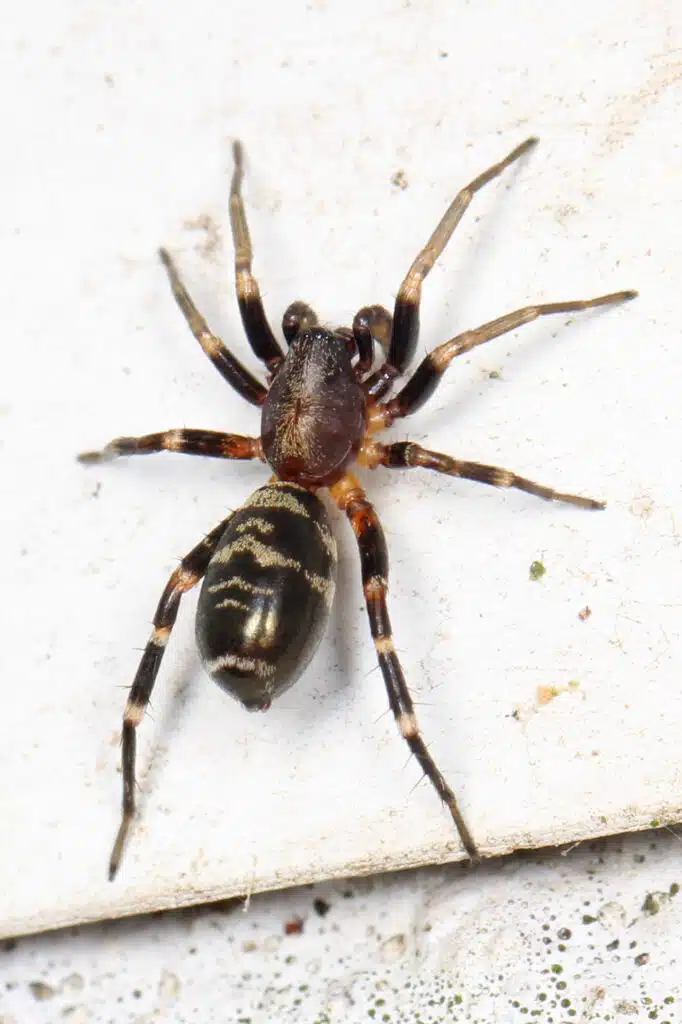
Scientific name: Castianeira longipalpa
Common name: Long-palped ant mimic sac spider
The Long-palped Ant-mimic Sac spider is a species that mimics ants.
Spiders of this genus are not known as dangerous to humans. Most bites aren’t followed for acute pain as this species cannot pierce human skin.
Male and female spiders are known for having different coloring.
Females are brown and black. Males have a mostly black body with white markings which can sometimes be tan.
Both the male and the female are predatory and they don’t spin spider webs.
They move along grass, vegetation, and flowers, seeking small insects.
It’s believed this species tries to resemble ants to escape dangerous spider predators.
As with all spiders that mimic ants, the Long-palped Ant-mimic Sac spider has an atypical elongated spider body.
This makes it resemble ants.
20. Two-lined Stealthy Ground Spider – White Spider with Black Stripes
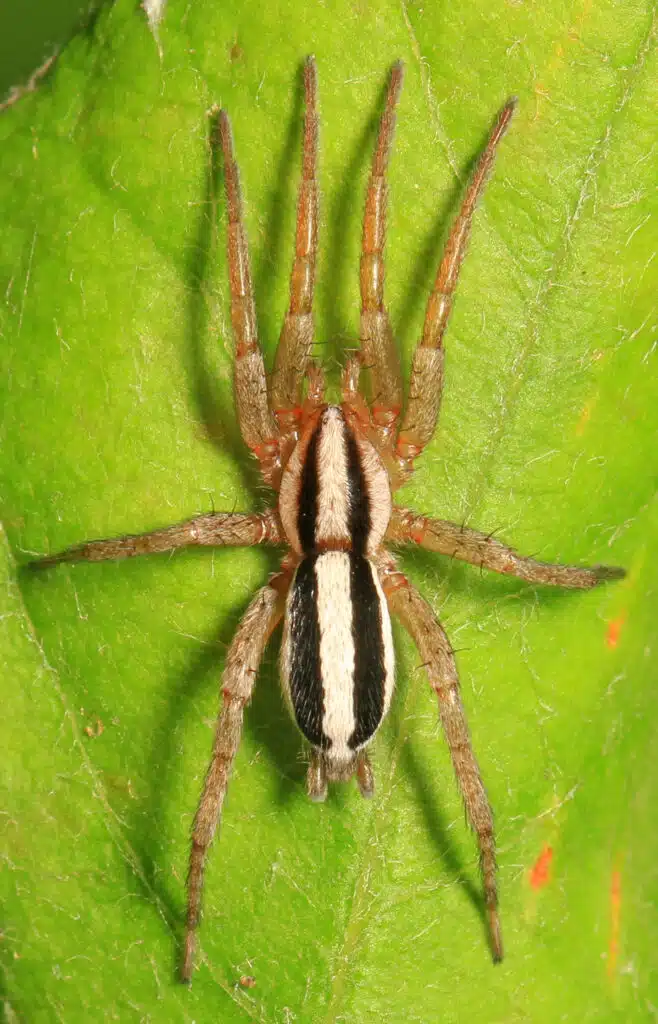
Scientific name: Cesonia bilineata
Common name: Two-lined stealthy ground spider
The Two-lined Stealthy Ground spider is one of the species with black and white coloring both in males and females.
Its entire body is covered by 2 black stripes and one longitudinal white stripe except for the legs.
Spiders of this genus love moisture. They live in basements and in abandoned buildings where they can find insects that love moisture.
They’re also common in attics where they eat insects and other spiders.
Spiders of this genus are venomous. They use their venom to paralyze small prey.
This venom has no medical significance as it’s not dangerous to humans.
Spiders of the genus are also seen outdoors looking for prey since they don’t spin webs.
They are common in Eastern states but their range is expanding to the West Coast starting with California.
Spiders of this genus aren’t venomous and they aren’t interested in humans.
They prefer to run away (at ground level) when seeing people.
21. Nordmann’s Orbweaver
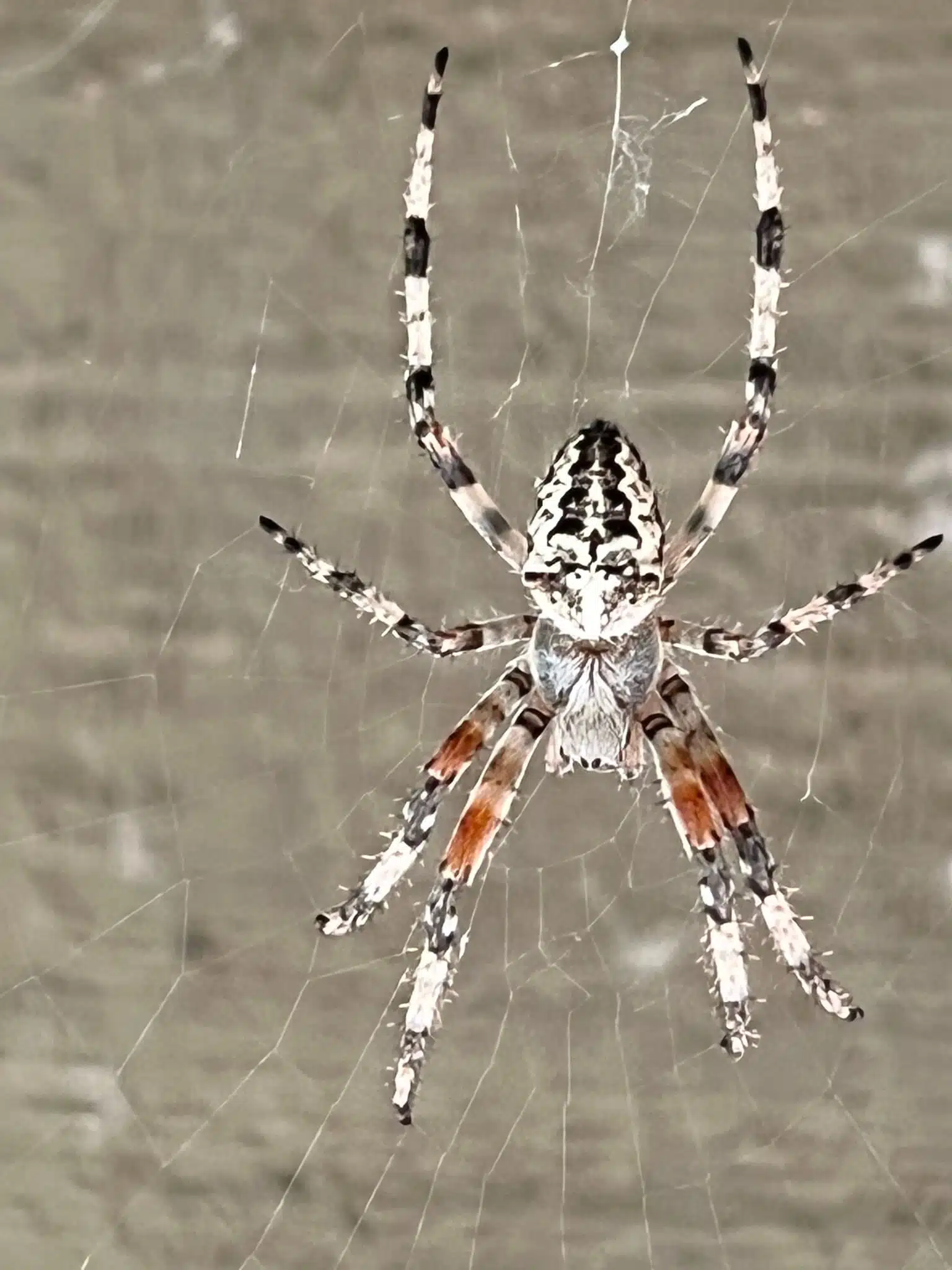
Scientific name: Araneus nordmanni
Common name: Nordmann’s orbweaver
This species of spider is a rare sight. It grows to 13mm being one of the largest orbweavers in North America and Europe.
The species is known for its black and white coloring or its black and tan coloring.
It has a black body and black legs.
The abdomen and cephalothorax are black with marbled white markings.
Its legs are also black with white markings.
Spiders of this genus are agile climbers and they can build spider webs high on trees or on tall grass.
Nordmann’s Orbweaver spiders build vertical orbital web weaves.
They catch small and large insects such as gnats, flies, and wasps.
In the rare sights of this species, the dominating female is seen in the center of the spider web.
Female spiders might live in the spider net in certain conditions. For example, they seek shelter under branches during heavy rain.
22. Twin-flagged Jumping Spider
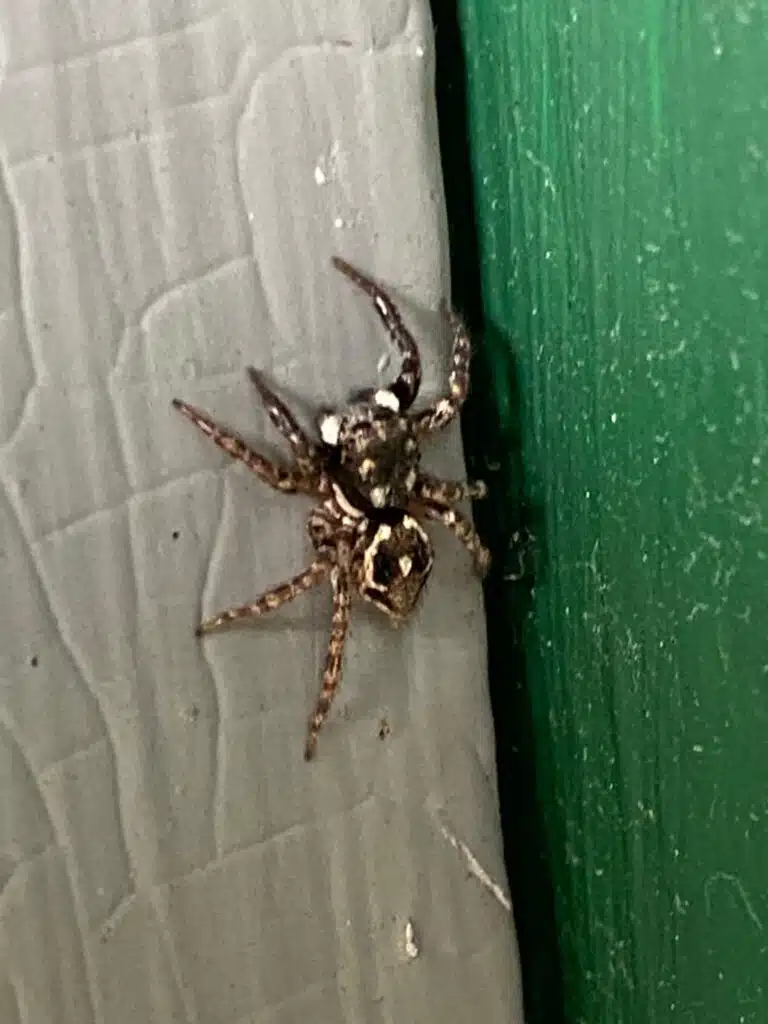
Scientific name: Anasaitis canosa
Common name: twin-flagged jumping spider
Twin-flagged Jumping Spiders are known for their black body with white setae.
Spiders of this genus have up to 4 white marks on their black cephalothorax.
Most members of this species look different as the Twin-flagged Jumping spider has high appearance variations.
This spider might come in different colors and with a different number of white marks on the cephalothorax depending on its environment.
It’s found on the ground where it moves all the time as this species doesn’t build spider webs.
Most Twin-flagged Jumping spiders live in forests. They can be found on forest floors where they roam for insects.
Some Twi-flagged Jumping spiders are also found in man-made structures. They can be found in homes, basements, and attics.
Twin-flagged Jumping spiders rarely move indoors as they look for insects.
They can be attracted to lights at night as insects might be hovering over artificial lights next to homes, bridges, and suburban areas.
Further Reading: